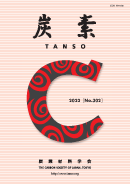
- Issue 302 Pages 63-
- Issue 301 Pages 1-
- |<
- <
- 1
- >
- >|
-
2022Volume 2022Issue 302 Pages Contents3-Contents4
Published: June 30, 2022
Released on J-STAGE: June 30, 2022
JOURNAL RESTRICTED ACCESSDownload PDF (236K)
-
2022Volume 2022Issue 302 Pages 63-71
Published: June 30, 2022
Released on J-STAGE: June 30, 2022
JOURNAL RESTRICTED ACCESSDownload PDF (1370K)
-
Junichi Nishijo2022Volume 2022Issue 302 Pages 73-79
Published: June 30, 2022
Released on J-STAGE: June 30, 2022
JOURNAL RESTRICTED ACCESSA substance in which a metal ion is bonded to an acetylide anion (R-C≡C−) is called an acetylide. Because of the instability of the acetylide anion, which has a negative charge and unsaturated bonds on carbon, the ethynyl group polymerizes while the metal ion is reduced by light or heating, resulting in the decomposition of the acetylide into a nano-sized mixture of neutral metal and carbonaceous materials. Using this reaction, it is possible to construct aligned metal nanoparticles or nanoporous graphitic carbon materials.
View full abstractDownload PDF (5198K)
-
Shohei Maruyama2022Volume 2022Issue 302 Pages 80-82
Published: June 30, 2022
Released on J-STAGE: June 30, 2022
JOURNAL RESTRICTED ACCESSThis thesis, consisting of three parts, focuses on graphite materials used as a negative electrode of lithium-ion batteries. Their electrochemical behavior, such as co-intercalation of solvents with lithium ions, electrolyte decomposition, and structural changes during lithium-ion intercalation, was investigated and correlated with graphite structure. In the first part of this thesis, co-intercalation behavior of solvents with lithium ions and the effect of solid–electrolyte interphase (SEI) on it were investigated using Raman spectroscopy. The Raman spectra clearly indicated solvent co-intercalation into graphite. After the SEI was formed on the graphite electrode, the solvent co-intercalation was partly suppressed. The suppression ability was dependent on SEI-forming reagents and ability of electrolyte solutions to repair SEI. In the second part, electrochemical behavior of graphitized carbon nanospheres (GCNSs), which have characteristic structure, was discussed. The GCNSs exhibited various unique properties such as high-rate capability and applicability in a propylene carbonate (PC)-based electrolyte solution. The structural changes during lithium-ion intercalation and deintercalation were investigated for the GCNSs with different average diameters and heat-treatment temperatures, and they were dependent on the graphite stacking structure of the GCNSs. The electrochemical behavior in a PC-based electrolyte solution was also correlated to the stacking structure and surface structure of GCNSs. Additionally, solvent co-intercalation into GCNSs and the effect of the SEI on the co-intercalation were investigated. In the third part, carbon nanofibers fabricated by graphite exfoliation followed by heat treatment were examined for negative electrode application. The nanofiber heat-treated at 400 °C exhibited a good high-rate capability.
View full abstractDownload PDF (384K)
-
[in Japanese]2022Volume 2022Issue 302 Pages 83
Published: June 30, 2022
Released on J-STAGE: June 30, 2022
JOURNAL RESTRICTED ACCESSDownload PDF (762K)
-
[in Japanese]2022Volume 2022Issue 302 Pages 84
Published: June 30, 2022
Released on J-STAGE: June 30, 2022
JOURNAL RESTRICTED ACCESSDownload PDF (153K)
-
[in Japanese]2022Volume 2022Issue 302 Pages 85-86
Published: June 30, 2022
Released on J-STAGE: June 30, 2022
JOURNAL RESTRICTED ACCESSDownload PDF (3778K)
-
2022Volume 2022Issue 302 Pages 87-88
Published: June 30, 2022
Released on J-STAGE: June 30, 2022
JOURNAL RESTRICTED ACCESSDownload PDF (118K)
-
[in Japanese]2022Volume 2022Issue 302 Pages 89
Published: June 30, 2022
Released on J-STAGE: June 30, 2022
JOURNAL RESTRICTED ACCESSDownload PDF (222K)
- |<
- <
- 1
- >
- >|